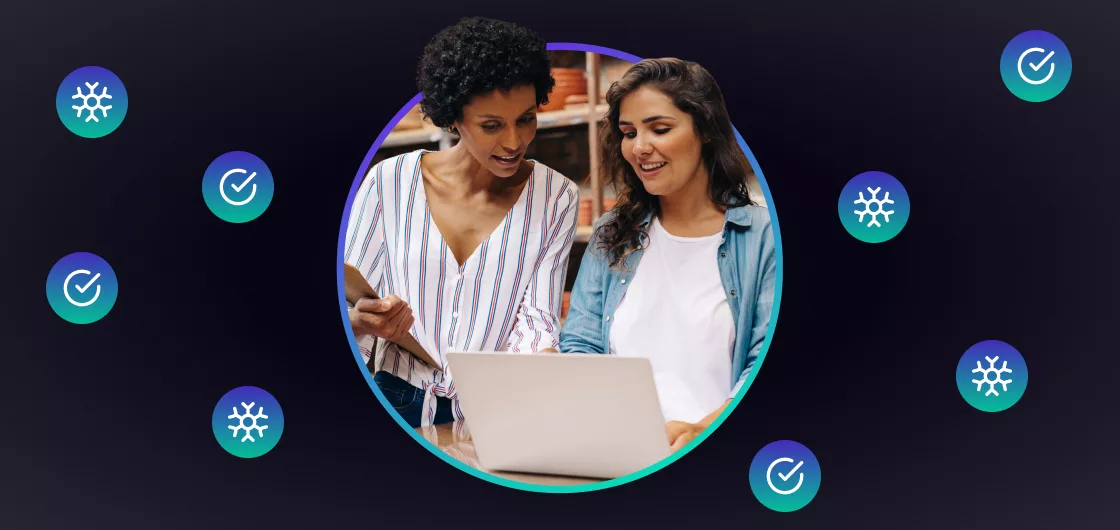The 2023 Holiday Strategy Guide to Acquire, Convert, and Retain Customers
Aug 31, 2023 | 24 minute read

Lindsay Kolinsky
Director of Marketing
Introduction

Megan Wenzl
Content Marketing Manager
The holiday season is fast approaching, and for ecommerce brands, it’s a critical time to capitalize on increased traffic and drive sales. With studies suggesting up to an 80% surge in website visits during this period, it’s essential to have a well-executed strategy in place to acquire, convert, and retain customers.
Of course, key to this is building great customer experiences that entice shoppers to engage – and ultimately spend – with your brand. Delivering a top-notch CX is top of mind every Black Friday and Cyber Monday. But this year above all, it’s imperative that these experiences foster loyalty, drive customer lifetime value, and maximize marketing spend during times of economic unpredictability and high customer expectations.
In fact, we already know consumers are getting more picky with their spending. Okendo’s research on retention and loyalty shows that heading into the holiday season, 80% of consumers are cutting their spending to some degree. This suggests that in order to take advantage of the opportunity that BFCM presents, brands need to fight through the noise and grab the attention of shoppers with truly personalized customer experiences.
In this comprehensive guide, we’ll walk you through the key steps to help you make the most of this opportunity. We include experts from some of the most innovative Shopify apps to offer their tips and strategies alongside us for a successful BFCM. This is your BFCM handbook, designed to equip you with the knowledge, insights, and actionable strategies necessary to triumph during this pivotal time of the year.
Let’s dive in and make this holiday season your most successful one yet!
Strategies and Tips to Acquire Customers
Using Reviews, Referrals, and Surveys to Maximize Sales Potential

Rachel Tyers
SVP, Marketing & Partnerships
As the holiday season approaches, the competition among ecommerce brands heats up, making it vital to capture the attention of customers interested in making purchases.
To stand out from the crowd and maximize your sales potential, you need to implement targeted strategies that specifically attract and engage your ideal customers. There are a range of effective strategies that can help you acquire customers who are not only interested in your products but also primed to convert, ensuring a successful holiday season for your business.
Incorporate Reviews into Ad Campaigns with Google Shopping and Seller Ratings
Customers flock to Google, with more than half saying when it comes to a purchase they plan to make online, they use Google for research. That means building an effective search strategy is paramount. Make use of Google’s powerful product search platform to showcase your store to a vast audience actively shopping.
Platforms like Okendo make it easy to enhance Google Shopping Product Listings and Ads with ratings, reviews and UGC, providing a highly effective way for merchants to optimize their Google Shopping campaigns and stand out from the competition.
In addition, brands should leverage Google Seller Ratings to showcase their store’s star ratings on Google Ads. Enhancing Google Ads with ratings are demonstrably proven to:
- Stand out in Google search results and increase CTR
- Drive more qualified, high-intent shopper traffic to merchant stores
- Decrease Google Ad costs and maximize campaign ROI
Displaying social proof is especially important for acquiring new customers during Black Friday and Cyber Monday. Nearly half (48%) of consumers surveyed by Okendo said that brands need to deliver “visible social proof i.e. customer reviews, user-generated content” in order to meet and exceed their expectations.
Showcasing your products on Google Shopping and leveraging Google Seller Ratings can provide potential customers with valuable insights into the quality and trustworthiness of your brand.
Implement a Referral Program
Implementing a customer referral program can be a game-changer for your business during Black Friday and Cyber Monday. Harnessing the power of word-of-mouth marketing, referral marketing is a highly effective and cost-efficient way to expand your customer base. By incentivizing existing customers to refer their friends and family to your brand, you tap into the trust and personal connections that drive purchasing decisions.
During the holiday rush, in particular, when consumers are actively seeking recommendations and looking for the best deals, a well-designed referrals program can generate a steady stream of new customers. This is because referrals act as powerful endorsements, carrying more weight and credibility than traditional advertising. In fact, referral marketing often has the highest conversion rate of all acquisition channels, leading to conversion rates of nearly 4X higher than the average rate of all channels.
Referral programs don’t stop there. The customers you convert and retain (keep reading below for conversion and retention tips) during BFCM can be leveraged to acquire new customers beyond the holiday season and into 2024 through your referral program.
Did you know? Okendo recently launched Okendo Referrals, making it easier than ever for DTC merchants to turn loyal customers into brand advocates by spreading the positive word about their brand to friends, family, and online peers. For more information, check out our Referrals announcement.
Track Customer Attribution with a HDYHAU Survey
Gain insights into which marketing channels your customers are coming from by implementing a “How Did You Hear About Us” (HDYHAU) survey. By understanding where your customers are coming from, whether it’s through social media, search engines, referrals, or other channels, you can focus your marketing efforts and allocate resources effectively.
This data also allows you to optimize your campaigns, target specific channels that are driving successful conversions, and refine your messaging to resonate with your target audience. You can then make data-driven decisions that maximize your customer acquisition efforts and ensure you’re reaching the right people during the holiday shopping rush.
Strategies and Tips to Convert Customers
Leverage the Power of Reviews, UGC, and Zero-Party Data

Rachel Tyers
SVP, Marketing & Partnerships
Once you’ve successfully acquired potential customers, the next step is to convert them into actual buyers. Here’s how you can unlock the full potential of your holiday marketing efforts, and increase your conversion rates:
Showcase Social Proof Across Your Site
Reviews have become an integral part of the buying process. Display reviews prominently on your product detail pages (PDPs) to provide valuable information to potential customers. You should also use reviews to showcase high-impact customer and product attributes, making it easier for shoppers to get the information that helps them make a more informed purchase. For example, if you’re an activewear brand it can be really useful to include a buyer’s height, their usual clothing size, and the clothing size they purchased with their review. This can also help reduce your holiday return rate by helping guide new shoppers to the right product for their needs.
Pay special attention to high-quality reviews featuring user-generated content. According to ecommerce trust research by Okendo, 87% of consumers find user-generated content (UGC) included in product reviews highly influential in their purchase decisions. The descriptiveness, authenticity, and transparency of these content-rich reviews have the power to grab the attention of prospective buyers and drive conversions. In addition, reviews displayed on your website should show recency to build trust that drive conversions.
In addition, be sure to integrate UGC and star ratings throughout your website, including category pages and media carousels. This showcases social proof at every touchpoint, reinforcing trust and confidence in your brand. You want to make sure your review display matches the look and feel of your brand for a consistent experience throughout your website. A platform like Okendo gives you customization options to make sure you’re never off brand.
Use Social Proof in Abandoned Cart Emails
When a shopper abandons their cart, they often need an extra nudge to complete their purchase. Enhance your abandoned cart email campaigns by incorporating social proof, such as real customer reviews, testimonials, or user-generated content (UGC). This adds credibility to your communications, enhances trust, and increases the likelihood of conversions.
Ensure Speedy Website Performance
Consumers have little patience for slow-loading websites. In fact, 70% of consumers say that page speed impacts their willingness to buy from an online retailer. Therefore, a sluggish website can lead to frustration, abandoned shopping carts, and lost sales opportunities.
To meet customer expectations on speed, ensure your website is fast and responsive. This requires eliminating bloatware such as unnecessary extra functionalities, apps, and plugins that are slowing down page load times. This is a simple and effective way to speed up your website by reducing the resources that need to be loaded when a user visits the site.
With social proof being such a crucial component of BFCM success, it’s important to choose a reviews platform that understands the critical role speed plays in driving customer engagement. This will allow you to optimize your reviews strategy without sacrificing speed.
Leverage Quizzes
Gain deeper insights into your customers’ preferences, requirements, behaviors, and demographics by utilizing quizzes. Quizzes help brands facilitate personalized product recommendations and guide the shopping experience, which is especially important during the holiday season.
Furthermore, quizzes create a sense of involvement and make the shopping process more interactive, increasing customer engagement and driving conversions. Consider offering incentives such as exclusive discounts for completing a quiz. This can further motivate customers to make a purchase, making it a win-win strategy during these crucial shopping events.
Implement 1-2 Self-Identification Questions On-Site and Prioritize BFCM Sales Messaging

The holiday season is tricky to plan for because there are many ways to target your audience to get results (aka conversions!).
Begin capturing more self-identification data from your visitors now in order to increase conversions during the holiday season. Most likely you have a lead capture on your site, and most likely you have that firing pretty soon when someone arrives on site. The tip falls in here. You’ll want to add in a question or two here (Who are you shopping for? Share your birthday to join our birthday club!, etc.).
The beauty of your lead capture is that it’s the best time to capture zero-party data (information that is intentionally & voluntarily shared) so that you can personalize their experience on-site and offsite (I’m talking to you Email, SMS, & Social Channels). By being proactive in collecting self-identification info from your visitors you are able to combine that with their behavior on site. For example, if they’re exiting your site you can show them the most relevant content (AI powered product recommendations by Justuno, shopping guides, BNPL options, product/brand education, UGC, etc.) based on what they have shared from your well-crafted discovery questions. Implementing this data capture tip is key to continued quality engagement with your visitors and customers during the holiday season.
Basically, we want it to be hard for them to ghost you and visit a competitor! Part two of this tip is to prioritize the BFCM sale messaging over a lead capture during BFCM. This means presenting offers in pop-ups that are unlocked (no email or sms needed to redeem). We want to avoid any barriers that may lead to an exit or prolonged conversion journey.
Merchandise for Maximum Conversions this Black Friday

The pinnacle of the ecommerce calendar, Black Friday, is the busiest and most lucrative time of year for most online retailers. But, it’s also the weekend that generates the fiercest competition.
With online shoppers looking to spend, it’s imperative that brands deliver an exceptional shopping experience that’s easy to navigate and encourages shoppers to convert. And a well-crafted merchandising strategy is one of the most effective ways to captivate shoppers at first glance during Cyber Weekend.
For high-profile events like Black Friday, it’s a good idea to create dedicated campaigns or category landing pages that you can direct all relevant search queries to. Create specialty merchandised gift guides for shoppers such as “Men’s Gifts Under $50” and landing pages featuring specific collections like best-sellers or promotional items.
Then, add banners to broadcast relevant offers and seasonal products, motivating customers to make quick purchasing decisions. The easier you make it for shoppers to find what they need, the more they’ll spend and the happier they will be – leading to increased conversions and loyalty.
During the busy holiday season, your team has enough stress on their plate without having to also wake up at 5 a.m. to manually merchandise the online store. Prepare your merchandising campaigns well in advance and test them. Once you’re satisfied, schedule your merchandising to launch at a time that makes sense for your brand and customers. When it’s all over, set a specific time to automatically deactivate seasonal campaigns so you don’t inadvertently run a promotion for longer than intended.
Black Friday is one of the most competitive dates in the ecommerce calendar. To stand out, merchants must deliver effortless shopper journeys, captivating product displays, and clear promotions. By implementing a well-rounded product merchandising strategy, ecommerce merchants can effectively drive more sales and make the most of the busiest holiday shopping season of the year.
Personalize Your Subscribers' Shopping Experience this BFCM to Drive Conversion

The holiday season can be retailers’ most lucrative time of the year, but the competition is fierce. To stand out from the crowd, brands are increasingly looking to SMS and email to grow their bottom line. But, strapped for resources, it’s hard to find the time to create hyper-personalized, orchestrated SMS and email marketing campaigns that you know will drive results.
While SMS and email are great channels on their own, we know the real magic comes when brands coordinate communications across touchpoints—paired with the right segmentation strategy to send messages to your subscribers that feel like they’re just for them. Also, using zero- and first-party data you’ve collected from subscribers to send personalized recommendations that increase your customer’s lifetime value (LTV).
Getting SMS and email to work together is now easier said than done this holiday season with Attentive AI. Our Automated Campaigns tool is trained on 1.4 trillion data points—and your brand’s historical data, helping to create copy and high-ROI segments to target your subscribers with product recommendations based on past purchase data, product views, and items they’ve added to their shopping cart to drive conversion.
See Attentive AI in action.
Real-time Attribution x Historical Cohort Analysis is the Key to Q4 Financial Success

We only have less than 90 days before the end of the year, so let’s get right into it.
The objective of this tip is to understand your exact new customer acquisition cost target for the months of September through November so that you can scale confidently while achieving a positive new customer contribution dollar output.
Open Triple Whale’s cohort analysis tool and query the date range for January – December, 2022 and ensure you have the cohorts grouped by month or week.
- Take a look at your historical CPAs, first order values, & 3-month cumulative values for the year, then specifically for September – November
Hopefully, your 3-month cumulative value for customers acquired in September + October is higher than the average of the customers acquired in earlier months.
Typically, customers acquired in September & October have a higher likelihood of repurchasing during the holidays (November – December) if they like your brand. Thus, increasing the amount they’re worth to you within 90 days of their first purchase (LTV).
Now, let’s start forecasting out your acquisition cost target (X) by determining your desired 90d Contribution Dollar output using a mix of historical numbers and your expected numbers for this year.
**90 Day Contribution Dollars** = *90 day LTV – Average Cost of Delivery (usually around 40% of LTV) – X (your acquisition cost target)*
Here’s an example:
$150 (90 day LTV) – $60 (40% of LTV for cost of delivery) – $40 (contribution dollar target) = $50 Cost per Acquisition target
Now that you have your target, go scale your best ads through your best channels. Use Triple Whale to monitor your nCPA target daily to ensure you’re not wavering from your plan. As long as your AOVs are meeting your expectation (remember that cohort analysis you did) and your nCPA is at or below the target above, keep pushing through September and October.
By the time November and December roll around you should do everything in your power to get as many customers who you acquired in September/October to purchase again, keeping in mind the avg. 90 day LTV target you set above.
Strategies and Tips to Retain Customers
Foster Loyalty and Build Community for Long-Term Success

Rachel Tyers
SVP, Marketing & Partnerships
Acquiring and converting customers is just the beginning of a successful Black Friday/Cyber Monday. To ensure long-term success beyond the holiday season, you must focus on customer retention and fostering loyalty. Implementing effective retention strategies can help you build a loyal customer base and create a sense of community around your brand. Here are some powerful strategies to consider:
Embrace Zero-Party Data
In today’s privacy-focused landscape, relying on third-party data is becoming increasingly challenging. Instead, focus on zero-party data—the information customers willingly provide directly to you.
By leveraging the data your customers provide in reviews, surveys, and quizzes, such as preferences, interests, and purchase history, you can create personalized and tailored experiences. This allows you to deliver relevant content, recommendations, and offers that resonate with individual customers, strengthening their connection to your brand. You can use tools like Attentive to send personalized product recommendations based on customer data you’ve collected to increase lifetime value.
For example, a beauty brand could ask customers to complete a skincare quiz to understand their specific needs and provide a personalized product recommendations on-the-spot. Similarly, a sportswear brand could ask customers their favorite way to work out, using their responses to send personalized content optimally designed for their specific interests.
Develop Referral and Loyalty Programs
We already talked about the value of referral and loyalty programs for acquiring new customers. But rewarding your loyal customers and brand advocates is an effective way to foster loyalty and encourage repeat purchases.
By incentivizing customers to refer others to your brand, you create a sense of exclusivity and turn your customers into brand ambassadors. Offer rewards, discounts, or exclusive access to new products or events for customers who refer others or make repeat purchases. This not only strengthens the bond between your customers and your brand but also helps you acquire new customers through the trusted recommendations of your existing customer base.
Build a Community
Building a community around your brand goes beyond transactional interactions. It involves creating a space where your customers can engage with each other, share experiences, and connect with your brand on a deeper level. Leverage the data you have about your customers to send personalized messages and offers that align with their interests and values. For example, if you sell athleisure and know you have a segment of customers who love running, you can organize running meetups in their area. This allows your customers to connect with like-minded individuals, foster a sense of belonging, and establish a strong emotional connection to your brand.
By embracing zero-party data, implementing referral and loyalty programs, and building a community around your brand, you can foster loyalty, create a strong emotional connection with your customers, and cultivate a sense of belonging. These strategies not only encourage repeat purchases but also turn your customers into brand advocates who will promote your products and services to others beyond the holiday season.
Seize the Retention Opportunity in BFCM With Giftable Subscriptions

Cyber Monday 2023 is expected to bring in a whopping $13.7 billion dollars. With the majority of these buyers purchasing one-off products and gifts, capturing customers’ loyalty and ensuring they come back for more can be a challenge during this peak season.
One of our best tips for growing your subscription offering this BFCM is to shift your focus toward the people your buyers are shopping for by offering a prepaid giftable subscription. With 68.4% of consumers who received a gifted subscription choosing to continue their subscription, your best shot at meaningful retention for your subscription offering is to cater to this audience.
After equipping yourself with subscription functionality that allows for out-of-the-box maximum/minimum billing cycle features like Smartrr’s, step one is to effectively market your giftable subscription. We’ve seen impactful campaigns targeting the concept of ‘giving the gift that keeps on giving.’ Display your giftable prepaid subscription on the homepage of your DTC site, making sure to clearly offer multiple subscription frequencies and overall packages to cater to different audiences.
Now is where the meaningful work starts. Once the subscription recipients start activating their subscriptions, cultivate a VIP experience to capture their loyalty. Welcome subscribers with personalized email and SMS messaging coupled with exceptional customer support.
Finally, at the end of the prepaid subscription period, sending a prompt email offering for consumers to opt into a subscription of their own is a wise move. Sweeten the deal with a bonus discount or loyalty points for continuing their subscription — plus, be sure to advertise subscriber-exclusive products.
Subscriptions are built on the opportunity to grow long-term relationships, and giftable subscriptions are your strongest avenue for cultivating this opportunity in the flood of BFCM one-time purchases.
Drive Loyalty Through Fulfillment

While you might think of logistics when you think of loyalty, the role that logistics plays in the customer experience is never greater than during peak season.
First and foremost, keeping up with demand and getting orders out to customers fast and at a low cost is critical to making sure products get delivered before any gift-giving begins. You’ll want to create a shipping calendar, build in padding for cutoff dates, and communicate order deadlines with your customers to maximize holiday sales.
Storing your products in more than one warehouse (across different regions and even in other countries) to strategically place inventory closer to more customers can reduce shipping costs and transit times (most easily achieved by partnering with a scalable 3PL). This also helps reduce risk if a fulfillment center or carrier gets overloaded during peak, or if carriers are unable to pick up due to severe weather, keeping orders going out and customers happy.
In addition to offering fast shipping, this also helps keep shipping costs low so you can offer free shipping without breaking the bank. By testing different shipping speeds and free shipping spend thresholds above your AOV to see what resonates, you can use the incentives that were important to those customers to get them to make a second purchase. As a bonus, you may even choose to display estimated delivery dates and fast shipping badges on your Shopify store’s product pages for eligible customers pre-checkout.
Finally, there’s no better open rate than the act of opening a delivery, so designing an unboxing experience that stands out can help give your brand an edge when it’s time for customers to reorder. The use of custom packaging, marketing inserts, gift notes, and other personal touches done at the packing phase of fulfillment can help with memorability.
Take Back Control of Your Order Tracking Experience

Given the costs of customer acquisition are rising, it’s more challenging and expensive than ever to acquire new customers.
According to industry reports, customer acquisition costs have increased by 50% in recent years and the days of first-purchase profitability are numbered. Since merchants typically see their biggest uptick in first-time buyers over BFCM, it is absolutely imperative they have a plan to retain these new customers and drive additional purchases after the holidays are over.
There is one simple retention lever that is often overlooked: branded & proactive order tracking. Research has shown that a staggering 84% of customers won’t return to a brand after experiencing just one negative shipping experience. This statistic emphasizes the need for Shopify merchants to prioritize the post-purchase experience over BFCM, or risk losing many of their very expensive new customers. By providing a personalized & branded tracking experience through a brand’s own site, addressing any issues promptly, and providing transparent communication, merchants can instill confidence in their customers and increase the likelihood of additional purchases.
Furthermore, focusing on customer retention during BFCM can have a significant impact on the profitability of each new customer acquired. Studies have indicated that first-time customers may not immediately generate high profits, but it’s the subsequent purchases that often lead to greater revenue. Repeat customers tend to spend more over time, with some reports suggesting that they spend 67% more than new customers. By retaining customers during BFCM, Shopify merchants can leverage this potential for future growth and profitability.
Customer retention is of paramount importance for Shopify merchants during the BFCM period. The rising costs of customer acquisition, coupled with the significant impact of a bad shipping experience, underpin the need to prioritize and invest in a delightful post-purchase experience. By providing personalized order tracking experiences, proactively communicating any shipping issues with new customers, and educating them on how to get the most out of their new purchase along the way, merchants can not only maximize profitability but also build a loyal customer base that will continue to generate revenue long after the BFCM frenzy has subsided.
Enhance your Post-Purchase Experience

Customer retention is about more than just making the sale — it’s about what happens after, too.
When a customer buys something from you this Black Friday or Cyber Monday, keep the conversation going. Send a personalized thank-you email, provide tips on how to use or care for the item they bought, or suggest related products they might like.
You may also offer exclusive offers or deals to those who complete a purchase, because there’s no better time to upsell than immediately after a customer’s already bought from you.
And during this high-volume shopping period, offer an extended return policy.
People often buy gifts, and knowing they can return items hassle-free can make them more willing to purchase. Be upfront about your return policy changes to build trust.
In fact, we recently uncovered that 93% of U.S. and U.K. shoppers consider flexible return policies key to their loyalty. But that’s not all.
54% of US shoppers always review a retailer’s return policy before making an online purchase—meaning your customers not only care about their post-purchase experience after they buy, but before they buy, too.
In short, treat your customers well after they’ve bought something.
The post-purchase experience can transform a one-off shopper into a loyal customer.
You don’t just want a successful Black Friday or Cyber Monday—you want customers who’ll come back again and again. That’s what makes your business grow.
Tackle BFCM support and Drive Post-Holiday Retention with Automation and Self-Service Resources

Black Friday and Cyber Monday (BFCM) are great opportunities for ecommerce businesses to attract new customers. However, the true value lies in retaining these customers beyond the holiday season. With rising acquisition costs and growing competition, brands need to prioritize customer retention to ensure sustainable growth. We‘ll explore a five-step retention strategy that brands can use to engage with customers effectively during Black Friday and beyond.
Offer omnichannel customer support.
Customers value immediate responses and prefer a variety of support channels. Meeting customers on the channels they already use can improve both engagement and satisfaction. According to insights from NewsCred, brands with omnichannel support have 23% higher CSAT scores. By leveraging a central helpdesk that keeps track of customer information in one place, brands can provide faster and more convenient assistance across channels.
Offer order management functionality.
Providing self-service options on your website, such as an FAQ page or automated responses in chat, empowers customers to find answers quickly and easily. Research indicates that 88% of customers expect online stores to offer self-service options, making it essential for a seamless customer experience.
Build a comprehensive help center.
Developing a robust and easily navigable knowledge base allows customers to access answers to common questions efficiently. By investing in a comprehensive help center, brands can scale their support capabilities while minimizing customer effort. Utilizing tools like Gorgias can streamline this process.
Utilize customer data.
By leveraging a customer service platform like Gorgias, brands can collect and consolidate customer data. This enables a deeper understanding of customer needs and allows for personalized and proactive support. Spending less time on redundant questions and more time anticipating customer needs enhances the overall experience.
Provide exceptional customer service after BFCM.
Gorgias research shows that repeat customers generate 300% more revenue than first-time customers. In order to boost retention, maintain loyalty, and enhance customer experience, brands should focus on providing great customer service year-round.
Though it might be tempting to prioritize top-notch support during high-sales seasons like BFCM only, it’s vital for sustained growth and can help maximize customer lifetime value long term.
Mastering the Holiday Season for Acquisition, Conversion and Retention
Remember, the holiday season isn’t just about making short-term sales; it’s about fostering relationships and building a solid foundation for sustained growth. And building long-term customer relationships is essential for sustained success in the ecommerce landscape.
By delighting customers with exceptional experiences, personalized engagements, and post-purchase care, you have the opportunity to transform one-time buyers into lifelong brand advocates this Black Friday and Cyber Monday. Implement the strategies outlined in this guide to acquire new customers, convert them into loyal buyers, and build a thriving community around your ecommerce brand. Stay focused, provide exceptional customer experiences, and make the most of this crucial time for your business.
Ready to learn more?